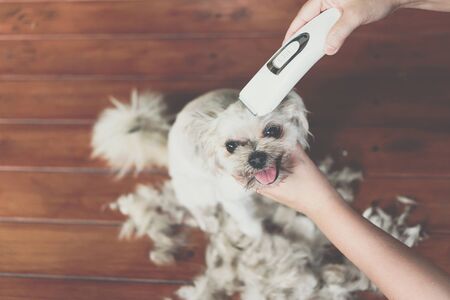Understanding Your Dogs Needs
Before you start grooming your dog at home, it’s important to recognise the signs of stress and understand your dog’s comfort levels. Dogs in the UK come from a wide range of breeds, each with their own grooming needs and temperaments. Some, like the laid-back Labrador, may be more tolerant of home grooming, while others, such as the alert Border Collie or sensitive Cocker Spaniel, might need extra reassurance. Pay close attention to body language such as tucked tails, flattened ears, panting, or restlessness—these are often early indicators that your pet is feeling uneasy. By understanding these cues and considering breed-specific personality traits commonly found in British households, you can tailor your approach and ensure that every grooming session is as calm and positive as possible for both you and your dog.
2. Preparing the Right Environment
Setting up a calm, safe, and familiar environment is crucial for keeping your dog relaxed during grooming sessions at home in the UK. Choose a quiet area of your home where your dog already feels comfortable—this could be their usual resting spot or a cosy corner with their favourite blanket. Minimise distractions by turning off the television, putting away noisy devices, and asking family members to give you space during the session.
Consider using calming aids that are widely available across the UK, such as dog pheromone diffusers. These devices release synthetic versions of natural pheromones that can help soothe your dog and reduce anxiety. You can find well-known brands like Adaptil in most local pet shops or online retailers. Additionally, playing soft classical music or gentle nature sounds can create a peaceful backdrop and further ease your dogs nerves.
Checklist: Creating a Calming Grooming Space
| Step | Action |
|---|---|
| Choose Location | Select a quiet, familiar room free from high foot traffic. |
| Remove Distractions | Switch off TVs/radios and silence mobile phones nearby. |
| Comfort Items | Place your dog’s bed, blanket, or favourite toy within reach. |
| Calming Aids | Plug in a UK-approved pheromone diffuser before starting. |
| Sensory Soothers | Play calming music at a low volume if your dog responds well. |
Taking these steps not only helps reduce stress but also promotes a positive association with grooming. By preparing the right environment, you’ll set the stage for a smoother, more enjoyable experience for both you and your dog.

3. Choosing the Right Tools
Ensuring a calm grooming experience for your dog starts with selecting the appropriate tools, especially those recommended by UK vets for your dog’s specific coat type. For example, if you have a Labrador or other short-haired breed, a rubber curry brush or bristle brush is ideal to remove loose hair and stimulate healthy skin. For dogs with longer or double coats, such as Collies or Spaniels, a slicker brush and a sturdy comb are more suitable to gently detangle and prevent matting without causing discomfort.
When purchasing grooming tools in the UK, it’s wise to consult your local veterinary practice for recommendations tailored to your pet’s needs. Many vets collaborate with trusted pet shops and can suggest brands known for their durability and comfort. Well-known retailers like Pets at Home, Jollyes, and independent pet stores across the UK typically stock vet-approved grooming tools. Additionally, farm shops and garden centres often carry reputable brands for rural dog owners. By choosing the right equipment from reliable sources, you not only support your dog’s health but also help them feel more relaxed during home grooming sessions.
4. Gradual Introduction to Grooming
When it comes to keeping your dog calm during home grooming sessions in the UK, a gradual introduction to grooming equipment and procedures is essential. Many British pet owners find that rushing into grooming can make their dogs anxious or resistant. By slowly familiarising your dog with brushes, clippers, nail trimmers, and other tools, you help build trust and reduce stress. Begin by simply allowing your dog to sniff and investigate each item. Offer a favourite treat or gentle praise when your dog shows curiosity or calm behaviour around the tools.
Step-by-Step Approach
| Grooming Step | Recommended Action | Positive Reinforcement |
|---|---|---|
| Introducing Equipment | Let your dog see and smell each tool without using it first. | Give a small biscuit or verbal praise like “Good boy/girl!” |
| First Contact | Gently touch your dogs fur with the back of the brush or comb. | Reward with a treat and soothing words in a calm British tone. |
| Short Sessions | Start with just a few minutes of brushing or handling paws. | End each session with playtime or a favourite toy. |
| Gradual Increase | Slowly increase the duration and complexity over several days. | Praise progress; use extra-special treats for milestones. |
Tailoring Reinforcement for UK Pet Owners
British dogs often respond well to gentle encouragement and traditional treats such as small pieces of cheese or specially formulated dog biscuits from local pet shops. Consider using phrases like “Well done!” or “Clever pup!” which are both familiar and comforting. Keeping sessions short and upbeat helps maintain a positive association with grooming activities. Remember, patience is key—every dog adapts at their own pace, so celebrate even small successes along the way.
5. Calming Techniques and Handling
When grooming your dog at home in the UK, employing gentle handling and calming strategies is essential for reducing stress and making the experience positive for both you and your pet. Start by ensuring your movements are slow and deliberate—sudden or rough actions can easily unsettle dogs. Use a soft, reassuring touch, always supporting sensitive areas such as the paws and ears. Speak in soothing, low tones throughout the session; your voice has a powerful effect on your dogs sense of security.
Popular UK-Recommended Stress Reduction Techniques
Many British dog owners find success using stress reduction methods recommended by local trainers and vets. For example, playing gentle background music or using products like plug-in pheromone diffusers (such as Adaptil) can create a calming environment. Additionally, offering natural treats approved in the UK, like small pieces of carrot or apple, can provide positive reinforcement and keep your dog distracted during tricky moments.
The Power of Routine
Keeping to a regular grooming schedule helps your dog know what to expect, reducing anxiety over time. Try to groom at the same time of day and in the same area of your home whenever possible. This familiarity fosters a sense of safety that UK behaviourists highly recommend for anxious dogs.
Building Trust Through Positive Association
Always end grooming sessions with praise or a favourite toy to reinforce positive associations. In the UK, many owners also use short breaks to prevent overwhelming their pets, especially if their dog is new to home grooming routines. Remember, patience is key—over time, these gentle techniques will help your dog remain calm and content during every grooming session.
6. Recognising When to Pause or Seek Professional Help
Even with the best intentions and preparation, there are times during home grooming sessions when it’s wise to pause or seek help from a professional. It’s important to be attentive to your dog’s behaviour and physical cues throughout the process. If your dog becomes extremely anxious—showing signs such as excessive panting, trembling, growling, snapping, or attempting to escape—it may be time to stop and allow them to settle down. Forcing a grooming session in these circumstances can increase stress and lead to negative associations with grooming.
Signs You Should Stop Grooming
If you notice any signs of distress, like sudden changes in breathing, yelping, persistent pulling away, or visible discomfort, halt the session immediately. Similarly, if you encounter mats or tangles that seem painful for your dog, or if you accidentally nick their skin, take a break and assess the situation calmly.
When to Consult a Professional Groomer
Some breeds have specific grooming needs that require specialised skills or equipment. If you’re struggling with difficult coats, stubborn mats, or tasks like nail clipping that make both you and your dog uneasy, consider booking an appointment with a qualified UK dog groomer. Many local groomers are experienced in managing anxious dogs and can offer advice tailored to your pet’s temperament.
When Veterinary Assistance Is Needed
If your dog shows ongoing signs of fear or aggression during grooming, has skin irritations, wounds, lumps, or any unusual symptoms uncovered while grooming, it’s essential to consult your local vet. They can rule out underlying health issues contributing to your dog’s discomfort and advise on safe grooming practices moving forward.
Remember, prioritising your dog’s well-being over completing the task is key. Taking breaks and seeking help when needed ensures grooming remains a positive experience for both you and your four-legged friend.


